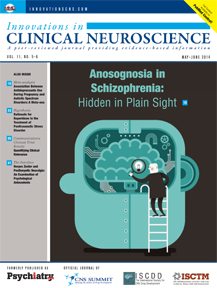Welcome to the May-June issue of Innovations in Clinical Neuroscience. This month we open with an interesting contribution by Lehrer and Lorenze titled “Anosognosia in Schizophrenia: Hidden in Plain Sight,” as part of the ongoing “Psychiatry and Neurology” article series. Here the authors review and discuss anosognosia, or the unawareness of deficit or illness, and how this phenomenon might apply to our understanding of insight deficits as treatable symptoms in patients with schizophrenia.
Next, Rais and Rais provide us with a meta-analysis titled, “Association Between Antidepressants Use During Pregnancy and Autistic Spectrum Disorders: A Meta-analysis.” The authors performed a literature search for original articles on the association between autistic spectrum disorders (ASD) and neurodevelopment delays in children and exposure to antidepressants during pregnancy. After performing a meta-analysis on the available data, the authors found that there is a positive association between the exposure to antidepressants in utero and autistic spectrum disorders.
Following this, Shuman and McGrane share a hypothesis on the treatment of posttraumatic stress disorder (PTSD) in their article titled, “Rationale for Iloperidone in the Treatment of Posttraumatic Stress Disorder.” The authors explain how the unique receptor binding profile of iloperidone, especially its high affinity toward alpha-1 receptors, warrants investigation into the use of iloperidone in the treatment of patients with PTSD.
Next, in this month’s installment of our ongoing article series “Communicating Clinical Trial Results,” Citrome cleverly explains how to measure effect size in order to quantify the clinical relevance of trial results in his article, “Quantifying Clinical Relevance.” Citrome presents data on the fictional antipsychotic medications, miracledone and fantastapine, to demonstrate how number needed to treat (NNT) and number needed to harm (NNH) can be used to quantify clinical trial results in a meaningful and practical manner in day-to-day clinical practice.
And finally, in this month’s installment of “The Interface,” Sansone and Sansone examine the relationship between stress and depression and the development of herpes zoster in their article “Herpes Zoster and Postherpetic Neuralgia: An Examination of Psychological Antecedents.” The authors found that stress, stressful life events, and depressive symptoms have been identified as antecedents to outbreaks of herpes zoster and its associated complication, postherpetic neuralgia. It would be prudent for both primary care and psychiatric clinics to keep this connection in mind when treating elderly patients, whom have been found to be at particularly high risk for developing herpes zoster.
We hope you enjoy the issue. As always, we welcome your feedback and submissions.
Sincerely,
Amir Kalali, MD
Editor, Innovations in Clinical Neuroscience






